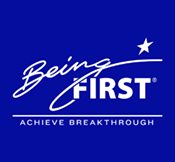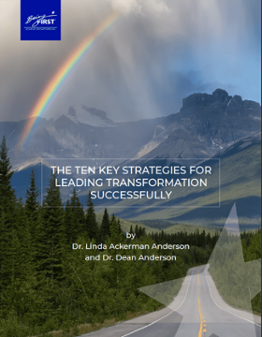There is an old saying: "You can give a person a fish and feed him or her for a day, or you can teach the person to fish and feed him or her for a lifetime."
This saying reveals a lot about the virtues of building your organization's change capability and skill.
In the past, executives had little interest in learning to fish. They just wanted the fish, the result they needed from their current change effort. Learning how to fish, or how to lead ongoing change, was of little importance. This made sense because executives saw little benefit from the massive undertaking of building their organization's change skills. In many cases, executives secretly hoped that once the current change was over, that would be it. They could go back to business as usual and not have to deal with the challenges of leading change again. Oh, have the times ever changed!
Now, most leaders realize that change is not going away, that it is speeding up and becoming more and more complex. Many executives see very clearly that their organization's future is in jeopardy unless they and their people "learn to fish." Developing change leadership skills and building organizational change capability has become one of the top endeavors of most visionary companies.
In this blog, we will identify seven key practices for successfully building your organization's change capability.
#1: Make Building Change Capability a Central Goal of Your Current Change Efforts
Building organizational change capability and skill is not an academic exercise. Change capability is not something your people will develop solely through training programs or by reading current literature. Sure, training and reading are often required, just as learning how to cast or how fish behave is needed of any competent fisherman. But the REAL learning occurs from going fishing yourself in the daily successes and failures of your actual change initiatives.
Because change skills are best learned in the trenches of your actual change efforts, you should make building change capability a central goal of all of your current change efforts. Not a goal separate from today's changes, mind you, but a goal of today's changes.
Furthermore, each of your initiative teams should contribute to the enterprise-wide strategy for building organizational change capability. They should also have clear implementation responsibilities regarding that overall strategy to carry out in their own change initiatives. By having both "global" and "local" responsibilities for building change capability, each change initiative team will contribute optimally to the effort's overall success.
#2: Real Sponsor Support and Change Leader Accountability
These go hand in hand.
The Executive Sponsor must see the value and be the champion of building change capability in your organization. Otherwise, the only pressure they will exert on change leaders and the only support they will provide will be toward achieving short-term change goals. As a result, building change capability will be overlooked in the execution of day-to-day change activities.
The sponsor must establish clear, specific, tangible change capability goals and hold each change leader and initiative team in the organization accountable for achieving them. This will catalyze the change leaders to build an overall change capability strategy, make provisions for teaching their constituents about change, and identify and communicate throughout the organization what is working and not working in their efforts.
#3: Make One Person Ultimately Accountable for Building Your Organization's Change Capability
Building change capability and skills is a huge task. Like all significant pursuits, it will only become real and be achieved to the extent that it is "managed" as a critical endeavor. Consequently, it requires leader accountability, an implementation team, a governing structure, resources, and support, just like any other executive function. Any less, and it will never happen. While all of your change leaders must be held accountable for their contributions to building your organization's change capability, one person should be ultimately responsible.
In many organizations, the Vice President of Human Resources takes this essential role as the change capability leader. This can work quite well because of the apparent need for change training as a part of the overall capability development strategy. However, it does not work when the VP of HR lacks credibility or the ability to influence line leaders or when HR services are perceived as non-value added overhead. In these cases, a line leader must be the accountable person because ultimately, building capability occurs most readily through the daily activities of running business-oriented, "line" change efforts.
A very effective strategy is to create a new office and role—the Strategic Change Office—and staff this office with competent change specialists. You may want your organizational development consultants, organization effectiveness consultants, change management specialists, process facilitators, etc., to report into this new office. Or this office may simply be responsible for optimally deploying these resources on change efforts, even though they report into different areas of the organization. The Chief Change Officer who leads this office should report directly to the CEO.
#4: Team the "Change Capability Leader" with the Current Change Initiative Leaders
Change capability is an enterprise-wide endeavor. Consequently, the structure established to produce it must support enterprise-wide success. The change capability leader must work in collaboration with the leaders of all the actual change initiatives. Otherwise, their job will get viewed as a "staff function," isolated from the real change work occurring in the organization, and it will become impossible for them to implement what is required to succeed.
Enterprise-wide change efforts require a Change Leadership Team to integrate and streamline all the change work occurring in the organization. The change capability leader must be on this team and the leaders of each key change initiative. That way, through its leader, each change initiative can input to the overall change capability strategy. It will also make it easier to integrate the change capability activities through individual change initiatives.
#5: Use a Common Change Process Methodology as the Roadmap for All of Your Change Initiatives
If all of your change initiatives use different approaches to leading change, building consistent change capability across your enterprise is challenging. When everyone uses a similar change process roadmap, you will have a common language, intent, strategies, tools, and activities so you can collectively determine what works and doesn't in various situations. A common change process methodology serves as the container for organizational learning about change and the development of collective best change practices.
Here's an analogy: imagine attempting to build best practices if each change initiative was playing a different sport. The basketball players would be basing what was and wasn't a best practice on very different criteria than the soccer players or swimmers. You don't need to dictate how each team plays, but you want to make sure that each initiative is on the same playing field, using similar equipment and applying strategies fit for the common game. That way, you can use the entire organization's collective intelligence to refine the play over time and build best practices that ensure long-term success in your league (marketplace).
#6: Include Employees at All Levels on Your Change Capability Team
The change capability leader will need a team to help design and implement the overall capability strategy. Employees at all levels of your organization should be represented on this team because all employees will need to build their understanding and skills about change. By having each employee level represented in your change capability team, you will design the optimal strategy for each type of employee. Such representation will also make implementing your strategy run more smoothly, with far fewer surprises.
#7: Reward Increased Change Capability
Your leaders won't pay adequate attention to building organizational change capability until you reward them for their efforts. If you tell them that building capability is important, but only reward their regular job activities, you won't get the dedicated effort you need.
Your HR department can help here. Have them establish, in collaboration with your line leaders, change leadership performance criteria. Identify what good change leadership looks like in your organization, and be sure to include criteria about building change capability. Also, be sure to have behavior and performance criteria that pertain to what your best change leaders must know, be, and do.
We feel strongly that in today's fast-paced, ever-changing marketplace, organizations should always build capability for future change while pursuing success in their current change efforts. There is no reason not to combine these two different - but related - endeavors. That is why at Being First, we emphasize change leadership development, license our Change Leader's Roadmap Methodology to clients, and teach them how to use it themselves. In our opinion, a change effort is not successful unless you get the results you need from it - AND - your organization simultaneously acquires both the change skill and the methodology to repeat the achievement of such change results over time. That makes us both fishermen and fishing guides.
RELATED EBOOK:
The 10 Key Strategies for Leading Transformation Successfully
RELATED WEBINAR:
How to Upskill Your Leaders' Change Capability to Continually Transform and Innovate
Dr. Linda Ackerman Anderson explores how to build Conscious Change Leadership capability and establish a change process methodology that honors the people and process dynamics of transformation while ensuring the best content solutions and results. Developing advanced Conscious Change Leadership skills and capability will enable you and your leaders to expand your perspectives and establish the required transformational strategies and processes to achieve your vision.
Watch and learn how you can:
- Expand your organization's approach to leading all its significant changes
- Consistently deliver superior results from change and transformation
- Unleash human performance in yourself and your stakeholders
- Remain adaptable and on-track amidst the complexities of our changing reality



